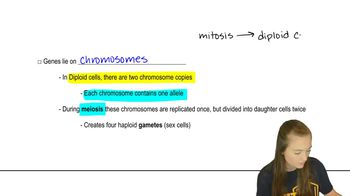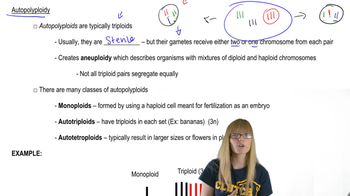Contrast the fertility of an allotetraploid with an autotriploid and an autotetraploid.
Table of contents
- 1. Introduction to Genetics51m
- 2. Mendel's Laws of Inheritance3h 37m
- 3. Extensions to Mendelian Inheritance2h 41m
- 4. Genetic Mapping and Linkage2h 28m
- 5. Genetics of Bacteria and Viruses1h 21m
- 6. Chromosomal Variation1h 48m
- 7. DNA and Chromosome Structure56m
- 8. DNA Replication1h 10m
- 9. Mitosis and Meiosis1h 34m
- 10. Transcription1h 0m
- 11. Translation58m
- 12. Gene Regulation in Prokaryotes1h 19m
- 13. Gene Regulation in Eukaryotes44m
- 14. Genetic Control of Development44m
- 15. Genomes and Genomics1h 50m
- 16. Transposable Elements47m
- 17. Mutation, Repair, and Recombination1h 6m
- 18. Molecular Genetic Tools19m
- 19. Cancer Genetics29m
- 20. Quantitative Genetics1h 26m
- 21. Population Genetics50m
- 22. Evolutionary Genetics29m
6. Chromosomal Variation
Chromosomal Mutations: Aberrant Euploidy
Problem 8c
Textbook Question
If the haploid number for a plant species is 4, how many chromosomes are found in a member of the species that has one of the following characteristics? Explain your reasoning in each case.
Octaploidy
 Verified step by step guidance
Verified step by step guidance1
Step 1: Understand the concept of haploid number. The haploid number (n) represents the number of chromosomes in a single set of the genome. For this plant species, the haploid number is given as 4 (n = 4).
Step 2: Define octaploidy. Octaploidy refers to an organism having eight sets of chromosomes (8n). This is a type of polyploidy, where the chromosome number is a multiple of the haploid number.
Step 3: Calculate the total number of chromosomes in an octaploid individual. Multiply the haploid number (n = 4) by the number of sets (8n). The formula is: .
Step 4: Explain the reasoning. Since octaploidy means eight complete sets of chromosomes, the total chromosome count is the product of the haploid number and the number of sets. This ensures the organism has eight times the genetic material of a haploid cell.
Step 5: Conclude the calculation process. The total chromosome count for an octaploid individual is determined by the multiplication performed in Step 3. This value represents the number of chromosomes in the organism.
 Verified video answer for a similar problem:
Verified video answer for a similar problem:This video solution was recommended by our tutors as helpful for the problem above
Video duration:
2mPlay a video:
Was this helpful?
Key Concepts
Here are the essential concepts you must grasp in order to answer the question correctly.
Haploid and Diploid Numbers
The haploid number (n) refers to the number of chromosomes in a gamete, which is half the total number of chromosomes in a diploid organism. In this case, if the haploid number for the plant species is 4, the diploid number (2n) would be 8, representing the total chromosomes in somatic cells.
Recommended video:
Guided course

Diploid Genetics
Polyploidy
Polyploidy is a condition in which an organism has more than two complete sets of chromosomes. Octaploidy, specifically, means that the organism has eight sets of chromosomes. This can occur through processes such as whole-genome duplication, which is common in plants and can lead to increased size and vigor.
Recommended video:
Guided course

Autopolyploidy
Calculating Chromosome Number in Polyploids
To determine the total number of chromosomes in a polyploid organism, multiply the haploid number by the number of chromosome sets. For octaploidy, with a haploid number of 4, the total chromosome count would be 4 (haploid) x 8 (sets) = 32 chromosomes in the octaploid plant.
Recommended video:
Guided course

Calculating Heritability
Related Videos
Related Practice
Textbook Question
771
views


